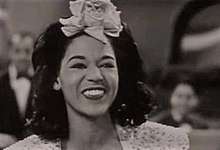Mable Lee
Mable Lee (August 2, 1921 – February 7, 2019), sometimes spelled Mabel Lee, was an American jazz tap dancer, singer, and entertainer. Lee appeared on Broadway, at the Apollo Theater, and was known as "Queen of the Soundies" due to her numerous performances in the films.
Mable Lee | |
|---|---|
 Lee c. 1945. | |
| Born | August 2, 1921 Atlanta, Georgia, U.S. |
| Died | February 7, 2019 (aged 97) New York City, New York, U.S.[1] |
| Other names |
|
| Occupation |
|
| Years active | 1934–2018 |
Biography
Born in Atlanta, Georgia, to Rosella Moore and Alton Lee, Mable Lee was a child prodigy who began performing when she was 4 years old, at age 9 was performing in local clubs with a big band and as a 12-year-old was appearing at the Top Hat nightclub in Georgia.
She moved to New York City with her mother in 1940 to pursue a career as a singer and dancer, and soon joined the chorus of the Apollo Theater in Harlem. She subsequently worked at various nightclubs, before going to London, where she spent 18 months and performed at the London Palladium.[2]
During World War II, she toured with the USO as a member of their first all-black unit. She was known for her dancing in over a hundred soundies in the 1940s.
Lee was featured on the cover of the March 1947 issue of Ebony.[3]
She also appeared on Broadway in multiple productions, including the 1952 revival of the musical Shuffle Along.
In 1956, she fronted an uncredited vocal group on the rhythm and blues ballad “Dearest Dream,” cowritten by Billy Dawn Smith and released by Hull Records.[4]
In 1960, she gave birth to her only child, a son, with Tony Mansfield, a musician.[1]
Lee was the 2004 winner of the Flo-Bert Award which honors "outstanding figures in the field of tap dance",[5] and a 2008 Inductee into the Tap Dance Hall of Fame.
Her last performance was in July 2018 at Symphony Space in Manhattan as part of the New York City Tap Festival.[1]
Lee died on February 7, 2019 at the age of 97 at a nursing home in Manhattan.[1][6]
References
- Seibert, Brian (February 14, 2019). "Mable Lee, Tap-Dancing 'Queen of the Soundies,' Dies at 97". The New York Times. Archived from the original on February 15, 2019.
- "Mable Lee [biography]". Library of Congress.
- Hill, Constance Valis (2009). Tap Dancing America: A Cultural History. Oxford University Press. pp. 144–145.
- Hinckley, David (February 11, 2019). "Mable Lee & What's a Tapper To Do When That Cat Just Can't Dance". Medium.
- "The Flo-Bert Awards".
- Santi, Christina (8 February 2019). "Famed Tap Dancer Mable Lee Dies at 97". Ebony.